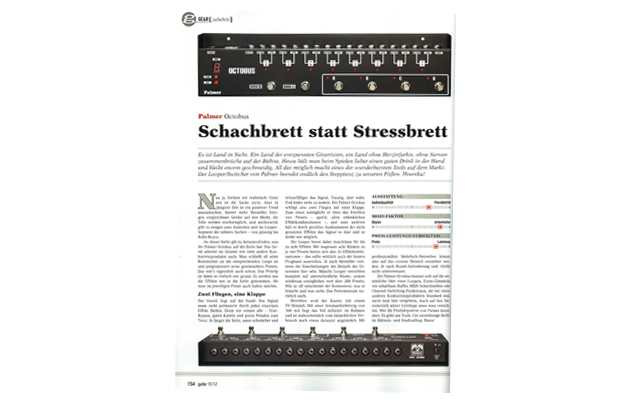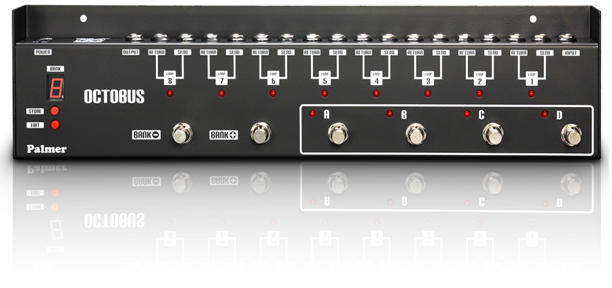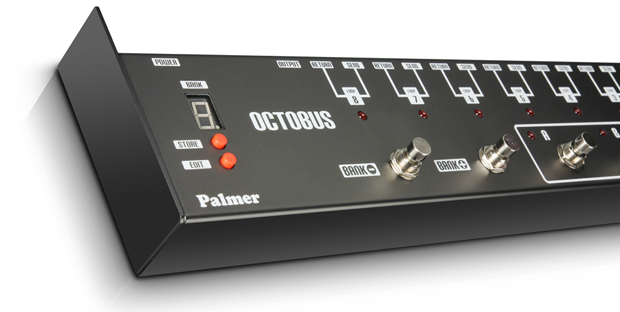Palmer Octobus – Chessboard Not “Stress Board” – Test Report by Guitar Magazine
There’s land in sight. A land of relaxed guitarists, a land without onstage heart attacks or nervous breakdowns. Today’s guitarist prefers a good drink in his hand when playing and stays real cool. What makes all this possible is one of the most wonderful tools on the market: Palmer’s looper/switcher finally puts an end to the tap dance beneath our feet. Eureka!  Now let’s stay realistic: This is not an entirely new thing: Lately, however, a positive trend has emerged. More and more manufacturers are marketing comparable devices. They are becoming affordable, and now there are quite a few to test and great things in the looper segment – from economy to Rolls-Royce.
Now let’s stay realistic: This is not an entirely new thing: Lately, however, a positive trend has emerged. More and more manufacturers are marketing comparable devices. They are becoming affordable, and now there are quite a few to test and great things in the looper segment – from economy to Rolls-Royce.
So now it’s time to find out what the Palmer Octobus has under the hood. Basically, it works just like many other competing products. You connect all of your effects pedals to the corresponding loops and program your desired presets. That’s really all their is to it. The principle is as simple as it is ingenious. Only those effects that you want to have in the respective preset are included in the signal chain.  Two birds with one stone The advantage is obvious: the signal does not have to flow permanently through each individual effect. For everybody knows – despite true bypass, good cables, and good pedals: the longer the signal chain, the weaker and more susceptible to interference the signal is. It’s sad but true, and nothing can change it. So the Palmer Octobus kills two birds with one stone. On the one hand, it makes it possible to create presets – in other words, all conceivable combinations of effects – and, on the other hand, it keeps the signal as clear and direct as possible by specifically eliminating the unused effects.
Two birds with one stone The advantage is obvious: the signal does not have to flow permanently through each individual effect. For everybody knows – despite true bypass, good cables, and good pedals: the longer the signal chain, the weaker and more susceptible to interference the signal is. It’s sad but true, and nothing can change it. So the Palmer Octobus kills two birds with one stone. On the one hand, it makes it possible to create presets – in other words, all conceivable combinations of effects – and, on the other hand, it keeps the signal as clear and direct as possible by specifically eliminating the unused effects.
The looper has connections for up to eight effects. Thus with a total of eight banks of four presets each, it provides 32 combinations of effects – that should really be enough for even the most progressive prog-rock band. Different manufacturers vary widely in their estimations of what guitarists need. Many loopers dispense completely with multiple banks, while others permit as many as 200 or more presets. Again, as is so often the case, consumers decide what they need and what they don’t. Of course, their wallets also decide with them. The box is powered by a 9V power adapter. With a power consumption of 300 mA, it is definitely reasonable and actually consumption is probably slightly less. Given the flexibility of professional multi power supplies, this means it is possible to do without the external power adapter. This is interesting depending on the demands and size of your board.
The Palmer Octobus focuses on the essential idea of a looper. There no extra gimmicks to be found such as the switchable buffers, MIDI interfaces or channel-switching functions that are standard in many competing products. You will also have to make do without a stereo mode. If you are familiar with the Palmer product range, you’ve already guessed: these are tools. They are dependable helpers in day-to-day life on stage and in the studio: nothing more and nothing less!
The dimensions of the Octobus have been kept pleasantly small. This is especially true when it comes to depth, which is expedient, since pedal boards usually revolve around arranging all the pedals for maximum logistical effect in a minimum of space. For despite all of the looper’s compactness, eight pedals, a power supply, a tuner, etc. is a lot of stuff any way you slice it.  Plenty of stuff Palmer products are built to be rugged. The thing is made of solid metal and makes a more than solid impression. Using top-class components is especially indispensible in a device intended to serve as the central nervous system of your pedal board. At the very least, it does not leave you with the feeling that you have to be especially careful with it. That would also be nonsensical in day-to-day onstage use. The switches are installed solidly in the unit and the sockets have a secure fit.
Plenty of stuff Palmer products are built to be rugged. The thing is made of solid metal and makes a more than solid impression. Using top-class components is especially indispensible in a device intended to serve as the central nervous system of your pedal board. At the very least, it does not leave you with the feeling that you have to be especially careful with it. That would also be nonsensical in day-to-day onstage use. The switches are installed solidly in the unit and the sockets have a secure fit.
There is one thing of which you should be aware when hooking up the unit. The sequence of the individual loops is not variable: You must always pay attention the direction of flow of the signal. It makes little sense to connect the delay to Loop 1 and the booster to Loop 8. If you really want to experiment like this, however, of course you can do it without any trouble. You can also occasionally drink a warm beer or stick your fingers in a blender …
The Octobus lets you do all of this, but of course it can’t do anything to improve the results. So you should pay attention to the order of your effects. On the whole, there are no limits placed on your fantasy in configuring your setup, and of course the device has true bypass. If nothing at all is selected, all of the effects are set to bypass and the input signal is sent straight to the output. It hopefully goes without saying that all of the effects must be on in order to run the entire setup.
Click track for explorers What’s cool is that all eight loops are also sends So it is no problem to realize A/B box applications with the device, since each of the sends can also be used as a normal output. This means that it is possible to toggle between two or even more amps. However, it is not possible to use multiple amps simultaneously. In this connection, it should noted that all of the effects that you want to have on each amp must take place before the respective send. But seriously: it’s nearly impossible to understand how this thing works.
The Octobus has a good signal-to-noise ratio. In the test setup, their was no significant extra noise due to using the looper. The only problem – which is regrettably shared by many devices of this type – is the more or less noticeable sound (depending on the configuration of the effects) when switching between presets This can be very discrete, but may also result in a clear “clicking sound” with certain effects. You’ll just have to see how frequently this occurs in your personal setup. It’s not as if this is going to break any windows, but it bears mentioning in the interest of fairness. In a band context with lots of distortion, this is certainly no tragedy, but it may be noticeable with clean modulation passages. There’s a reason why there are loopers in the high-end segment that have made avoiding switching noise a science of its very own.
The takeaway This will turn your “stress board” into a chessboard. You really can’t go wrong at a street price of just under 200 Euros. For that, you will get a reliably functioning tool built with flawless workmanship. Thanks to its size, anyone with more than two or three effects on his board should be able to find space for the looper in the first row. Otherwise, it’s time to consider a reconfiguration. The capabilities offered by this little helper are just too cool to pass up. And once you’ve become accustomed to the world of loopers, you’ll never want to go back…
Facts
Model: Palmer octobus
Class: floor
Effect type: 8x looper
Effects: 8: simultaneous
Presets: 32
Power: 9-volt power adapter
Dimensions: 44.4 x 11 x 4.5 cm
Internet:
www. palmer-germany.com
RRP: 220,- €
More information about the Palmer Octobus is available here:
http://www.palmer-germany.com/mi/en/OCTOBUS-8-Channel-programmable-Loop-Switcher-PEOCT.htm
Source: guitar Magazin, Germany, November 2012
Leave a Comment
You must be logged in to post a comment.












